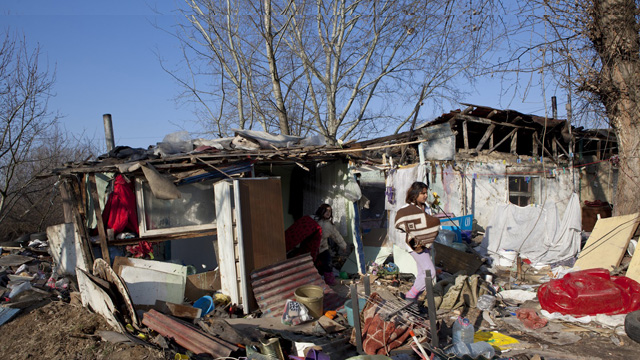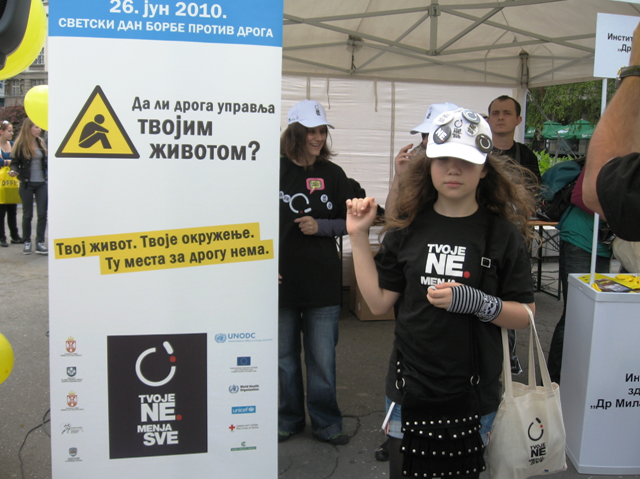Young Roma people in Serbia are particularly severely affected by the increase in use of traditional psychoactive substances, such as cannabis, inhalants (glue and solvents), heroin and alcohol. EDPI’s local partner, the NGO 'Re Generation', argues that these young people – a high proportion of whom live and work on the streets – are in need of special care.
Heroin and Roma youth
From early childhood, Roma youth are often involved in street work. Many of them earn some kind of an income by recycling waste, in dangerous and unsanitary conditions. This method of earning a living is prevalent in the majority of Roma settlements, but not all of them are tolerant of drug use, and communities are often divided along drug-user and non-user lines: There are examples where drug users are physically separated from the rest of the population, for example by living at one end of the local Roma settlement.
|
Roma minorities in Serbia According to the 2012 census, the official Roma population in Serbia numbered 147,604. There are about 600 Roma settlements in Serbia, 137 of them in Belgrade. Two thirds of Roma live in illegal and unregulated settlements, mostly constructed from cardboard and tin sheets with inadequate infrastructure. Roma in these settlements live in very poor conditions, with no access to running water, sewage connections or adequate toilets. The official unemployment rate is as high as 40.7%. Many Roma work informally, particularly at the micro-level, recycling rubbish in dangerous and insanitary conditions. The infant and under-five mortality rate is estimated to be three times as high as amongst the population as a whole. The 2010 Serbian Multiple Indicator Survey shows that only 8% of Roma children aged 3 to 5 are enrolled in formal early childhood education programs. Findings indicate that the literacy level of the population in Roma settlements is generally lower than for the national sample (only slightly over three quarters of people aged 15–24 in Roma settlements are literate). The worst situation is that prevailing among the poorest, of whom only about half are literate. Confidence in their own skills is very low, showing a significant correlation between low levels of educational attainment, and a low level of integration in the labour market. The roots of social isolation lie in poverty, inadequate education, stigma, and discrimination. |
An early rite of passage involves the inclusion of young people in their parents’ use of drugs. They often find themselves being involved in various ways – keeping guard, holding a tourniquet, or just playing with needles and syringes. Children grow up with injecting drug use as part of their everyday life, with Roma parents generally unaware how strong a risk factor this is. By the time they become teenagers, their drug career is often effectively pre-determined – far more so than is the case with young people in majority Serbian society. Patterns of behavior are inherited. In order to get money for drugs, young people from Roma settlements are increasingly involved in working on the street, with young girls especially gravitating towards sex work.
The vulnerability of Roma girls
 Lack of education is a major cause and consequence of poverty: 62 per cent of Roma in Serbia have no elementary education and 80 per cent are functionally illiterate. Only 4 per cent of Roma children under the age of six attend pre-school programmes and most young Roma have few opportunities for early childhood learning and stimulation. Roma parents, particularly mothers, are poorly equipped to provide adequate support to their children’s development and are often excluded from primary health outreach services which could help to build parenting skills. The lack of education goes hand in hand with the lack of drug prevention and sexual education.
Lack of education is a major cause and consequence of poverty: 62 per cent of Roma in Serbia have no elementary education and 80 per cent are functionally illiterate. Only 4 per cent of Roma children under the age of six attend pre-school programmes and most young Roma have few opportunities for early childhood learning and stimulation. Roma parents, particularly mothers, are poorly equipped to provide adequate support to their children’s development and are often excluded from primary health outreach services which could help to build parenting skills. The lack of education goes hand in hand with the lack of drug prevention and sexual education.
Roma girls are primarily inducted into drug use, especially injecting drug use, through the influence of their sexual partners. There is a general consensus that, unlike Roma boys, girls are not significantly affected by peer pressure when it comes to drug use. On the other hand, early marriage is still part of the Roma cultural tradition; and internalised gender roles impose on women a role of being marginalised, submissive, and powerless in relation to men. According to the 2011 UNICEF Multiple Indicator Cluster Survey, almost half of young Roma girls aged 15-19 have already given birth, 40% have experienced abortion, and 4% have had a child before the age of 15. The predominant risks among women are consistent with high-risk sexual activity. Many work on the street as commercial sex workers, even when they are pregnant. There is a huge knowledge gap about drugs, their effects and risks, with a widespread ignorance of the meaning of terms such as drug dependency, withdrawal, overdose, how drugs can influence the foetus, and so on. There is clear evidence of a correlation between low levels of educational attainment, and health risks, affecting both young Roma girls, and their children as well.
A few short testimonies illustrate the particular risk factors affecting Roma girls:
 “The first time I went to work on the street was with my older sister. I was 16. The guy that was giving us heroin for free drove us to a street, told us what to do and left us there. I felt afraid. I couldn't run away, because I didn't know where to go, and I needed heroin… “
“The first time I went to work on the street was with my older sister. I was 16. The guy that was giving us heroin for free drove us to a street, told us what to do and left us there. I felt afraid. I couldn't run away, because I didn't know where to go, and I needed heroin… “
“My sister had Hepatitis C, I used her syringe, and now I am HCV positive too. I didn't know that you could get hepatitis that way… the place where I live during winter is cold and dark, there's no electricity. I have difficulty finding a vein. We light a fire, but there's a lot of smoke, so you can’t see anything.”
“I didn't want to start sex work. I said I didn't know how to do that. He told me, do it as you do it with your husband. I was 18, married, and a sex worker.”
“While I was working on the street, I would bring my four-year-old daughter with me. She would hide in the bushes by the road and wait for me… It was dark and she was scared. I was scared too, for both of us.”
The predominant emotion expressed by these women is fear, both for themselves and for their children – fear of the unknown, and of violence, driven by the psychological coërcion imposed by drug dependence and social exclusion. They know that there is always a chance that government social workers may take away their children: This is what happens to many single-parent Roma families, even though separation from their children can hardly be considered a good foundation for moving forward to positive life-changes. Without knowledge or crucial information, the prospects for such positive changes are dim.
“Legally invisible” – the point where the vicious circle starts
This is not a closed circle; there is one crucial factor, which takes the form of “legal invisibility”. “Legally invisible” means that they have no birth certificate, and without it, cannot obtain any other personal documents, such as an ID or health card. In most cases, this is an inherited phenomenon, with the parents and grandparents of young Roma equally excluded from the Serbian legal system. As the Human Rights and Minorities Ministry confirms, there are currently close to 200,000 legally invisible Roma citizens in the country.
 This is the point where the vicious circle starts. A Roma girl, legally invisible, who may be a drug user/injecting drug user, a sex worker, a mother, HCV- and/or HIV-positive, isn't just on the margins of society – she's completely excluded from it. She bears the burden of stigma and discrimination, not only from the general population, but even from the Roma community. The culturally-embedded power imbalance exposes Roma girls to an increased risk of stigma, violence, and abuse – and in turn, these increase the likelihood that she will engage in behaviours which increase her vulnerability to HIV and other sexually-acquired conditions.
This is the point where the vicious circle starts. A Roma girl, legally invisible, who may be a drug user/injecting drug user, a sex worker, a mother, HCV- and/or HIV-positive, isn't just on the margins of society – she's completely excluded from it. She bears the burden of stigma and discrimination, not only from the general population, but even from the Roma community. The culturally-embedded power imbalance exposes Roma girls to an increased risk of stigma, violence, and abuse – and in turn, these increase the likelihood that she will engage in behaviours which increase her vulnerability to HIV and other sexually-acquired conditions.
The essential need: gender-sensitive programs
Harm-reduction programs do not currently include a special package of services targeting Roma girls. Children are not allowed to enter drop-in centres, so they have to wait outside. This prohibition limits the number of girls coming to collect sterile injecting equipment.
There is an essential need for gender-sensitive programs targeting the general population of young women, as well as Roma girls. The core activity of those programs should be outreach work with mobile teams. Experience of outreach work in Roma settlements confirms that education brings results – education about risk and risk-prevention filters through, across barriers of gender or age. Older people are willing to learn from the young, boys from girls, as long as there is significant information that will reduce the risks to which they are exposed. This activity needs to be widely available. Services should also provide continuous education and care for pregnant women and women with infants, in order to protect their health. There is a need to provide peer support, enabling Roma girls to feel less marginalised, and increasing their access to sterile injecting equipment and condoms. There is a need to recognise this population as a specific one, strengthening ongoing programs and creating new ones that will connect Roma girls to governmental institutions. Civil society organisations have a responsibility to help break the vicious circle and give Roma girls a better chance of a safer and more equal life.
Andjelka Jelčić, Re Generation




